My family and I boarded the Circumvesuviana train to head back to Sorrento, Italy, where we were staying for the night. We had just finished a tour of the ancient city of Pompeii, buried in ash by the volcano Vesuvius, which erupted in 79AD. The city is now a UNESCO site and tourist attraction since approximately 250 years after it was discovered; excavations began in 1748.
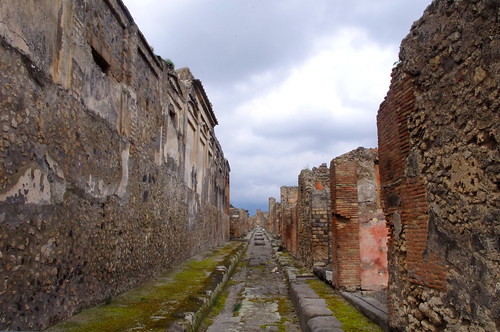
Through my mom’s contacts, we hired an archaeologist to give us an in-depth tour of the ruins. She brought the place to life with her detailed, knowledgeable descriptions. For example, she explained to us how archaeologists could figure out that the table counters on the side of the street with holes in them were used for selling fish soup to customers, because of the fish residue found on the rock below. It was as if we had been transported back in time and were in the city during its heyday. Much of what I heard and saw was fascinating. They used such intricate details in the building of their towns and homes, and their society had some surprising similarities to ours today, such as the fish soup food counters that were the “fast food” of their day.


I was particularly intrigued upon learning that in 1861, Giuseppe Fiorelli, an Italian archeologist who helped excavate and preserve Pompeii, thought of pouring plaster down holes where he’d probed and found only hollow spaces. He wanted to know the shapes or origin of the holes. When the plaster dried, he found casts of people and animals buried in the ash during the volcano’s eruption.
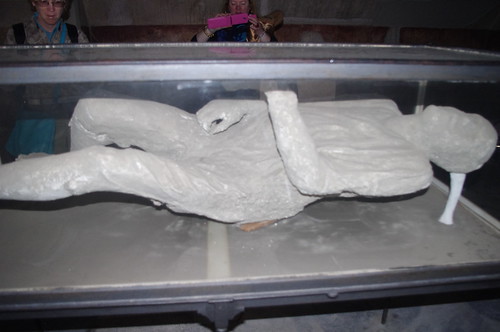
I fell asleep that night thinking about our fabulous visit to Pompeii and our upcoming fieldtrip the next day to the top of Vesuvius - the volcano that was responsible for covering Pompeii in ash.
I suddenly found myself braiding a young girl’s hair. I recognized that she was dressed in a toga. It took me a few seconds to realize I was dreaming and had been transported back in time. The style of the room we were in was reminiscent of ancient Rome. I noticed a fresco on the wall, which portrayed the young girl whose hair I was braiding. I gathered that she was rather rich.
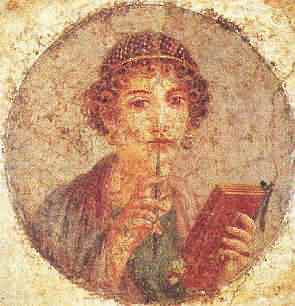
As soon as I finished her hair, she grabbed a bag and impatiently headed toward the door. An annoyed glance from her indicated that I was to follow. We passed what looked like a small shrine on the way out. When she saw me look, she explained we would worship as a family later that day at this small altar and that if we kept moving so slowly we’d miss the worship, hinting that I was moving too slow for her taste. I had the sense that I was supposed to be some sort of servant from the way she talked to me. However, I continued glancing into the shrine and see the family’s personal gods or spirits, called lares, displayed.
“You will accompany me to the spa,” she said authoritatively. As we walked, I recalled that the spa was a public bathhouse. When we entered the spa, I could see four different rooms. The first one acted as a locker room; the other three each had a different temperature of water. I remembered my visit to the ruins on our tour earlier that day, as I could recognize the bathhouses because they were mostly intact in the ruins, although now the walls were brightly painted.
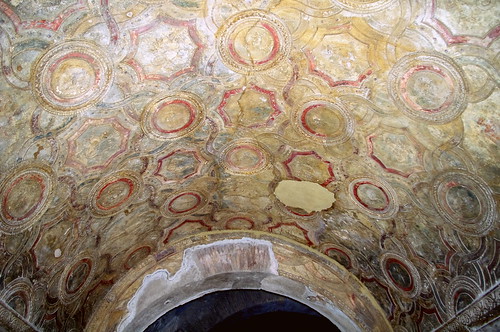
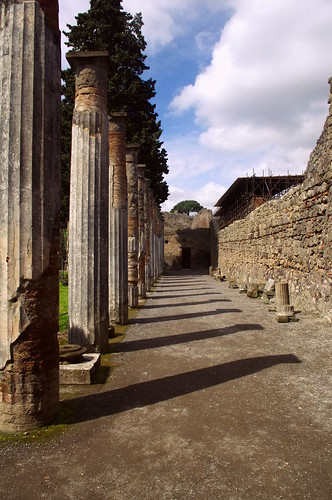
After leaving the spa, as we were walking among the hustle and bustle of the crowded streets, this time she didn’t bother to look back to see if I was keeping up. I sped up my steps only to stop as I felt the earth tremble. My mind flashed to the stories of the violent eruption of Vesuvius and I turned to see the mountain towering over the city. It was much larger pre-eruption than it was when I was in the ruins, because when the volcano erupted, the top of the mountain was blown off. The girl I was accompanying turned, noticed my anxious face, and said, “Oh, don’t look so worried, these earth tremors are normal.” Hungry, she rushed off through the people to go order fish soup from a marble counter along the street
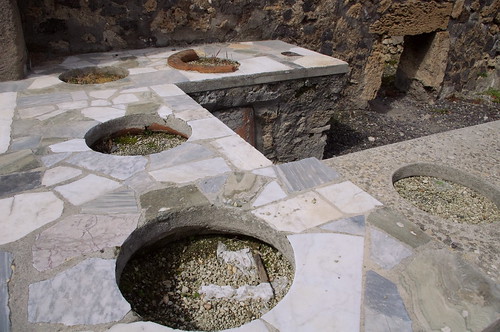
As I pushed through the crowd trying to follow her, a horse pulling a wagon full of passengers blocked my sight of her. I glanced around frantically and only saw more horses tied at the side of the street by ropes looping into stone holes. Horses were the main transportation of the day, besides feet, of course. I saw children pretending to fight like their favorite gladiators, and etching graffiti into the walls of the city while the adults were distracted. I saw women entering the many shops along the street — clothing stores, places to buy soap, and the food markets of the day. I was afraid I had lost the rich girl I was supposed to be following.
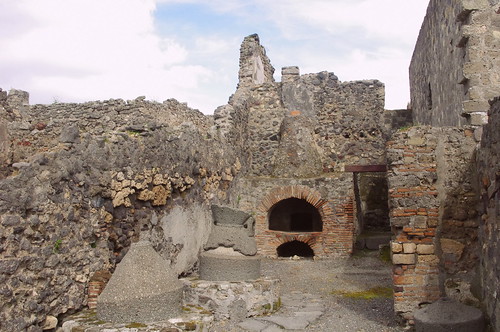
A bread shop with an oven.
Suddenly the sky turned black. I looked around and saw a column coming from the volcano where ash began to fall, spreading over the earth like a flood. It was like nighttime; however, there was a clear distinction between this and the normal darkness of a moonless or cloudy sky. This darkness was as if the lamp had been put out in a closed room.
I heard the shrieks of women, the wailing of infants, and the shouting of men. Some were calling to their parents, others to their children or their wives, trying to recognize them by their voices People were crying over their own fate or that of their relatives, and some prayed for death. Maybe some sought the aid of the gods, while others might have imagined there were no gods left. It seemed the universe was plunged into eternal darkness. If felt like a million tons of volcanic ash and rock were falling over the city every second. I blinked, to keep the gritty ash out of my eyes.
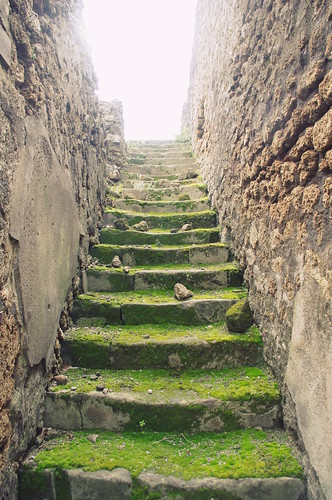
I opened my eyes to the blinding sun. To my relief, I was back in the present - in the ruins of Pompeii. As my eyes adjusted from the blackness of my Vesuvian dream, I saw a group of tourists standing around a young man who seemed to be a guide. He was reading Pliny’s account of the eruption- the man who witnessed and documented the event from across the bay. “I cannot give you a more exact description of its appearance than by comparing to a pine tree; for it shot up to a great height in the form of a tall trunk, which spread out at the top as though into branches… Occasionally it was brighter, occasionally darker and spotted, as it was either more or less filled with earth and cinders.” The largest and most violent of all the types of volcanic eruptions which send up enormous plumes of ash and gas are now known as Plinian eruptions. As exciting as it would have been to stay and see firsthand what else happened the day of the tragic eruption, I was glad to be safe exploring the ruins in 2013. I was left to only imagine what was happening to the screaming people I was surrounded by in my dream.
I felt someone squeeze my hand. I looked down and saw it was the young girl whose hair I had been braiding back in Ancient Pompeii. She had a shocked expression on her face as she looked at the ruins with people in strange clothing who were happily exploring her ruined town. I wondered how to begin to explain to her where we were…
Sydney Kahl is a member of the Youth Travel Blogging Mentorship Program
All photos courtesy and copyright Sydney Kahl
